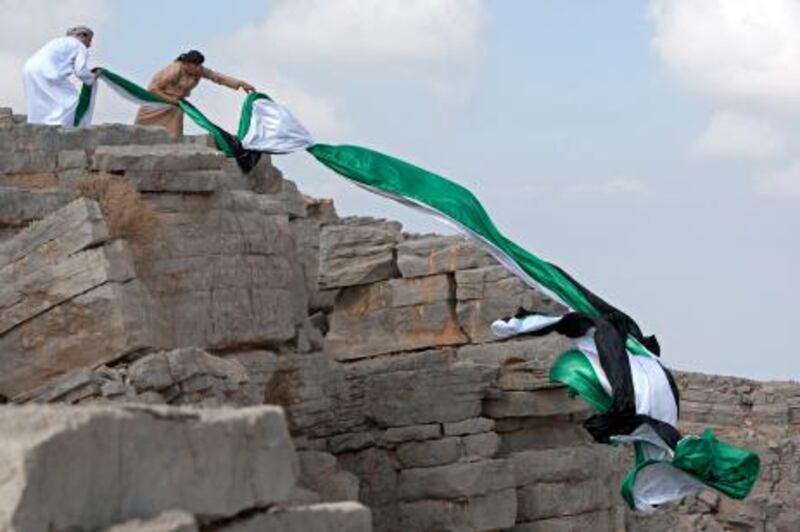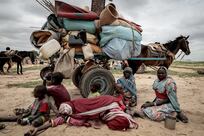Ras Al Khaimah // Ahmed Bin Shaiban and his son, Shaiban Bin Ahmed, did not wear their thick National Day scarfs for style Thursday morning.
They set off before dawn to cross the mountain of Jebel Janas and the village of Al Sel to hang a 40-metre UAE flag from a cliff face over their father’s home in Wadi Qada’a.
As they ascended in the predawn light, their only warmth came from the scarfs and the heat generated by their quick footsteps.
The father and son were among thousands of mountain tribesmen who dangled themselves over cliffs to place enormous satin flags above their mountain villages in the week before National Day.
“If the flag is high, the country is high,” Ahmed told his son. “When the flag is down, the country is finished.”
The first famous mountain flag was planted in 2006 and it quickly became a National Day tradition. Today, every mountain in RAK bears a flag.
Shaiban, age 10, is named for his grandfather, the revered leader of the Habus mountain tribe, who extend from Khatt to Al Rams and the Oman border.
This was his first trip to the top of the mountains. He wore velco trainers and a fatigued smile. His father’s footsteps were more certain: Ahmed, 35, visited these mountains every week until he began work in Abu Dhabi.
They were joined by Ahmed’s brothers Mana, 21, and Waleed, who is in his 40s. Mana carried the 10kg flag in a plastic bag slung over his shoulder.
The hike was a history lesson for Shaiban. The family crossed trails that lead between stone houses used for hundreds of years until they were abandoned 40 years ago. The trails are invisible to most but the polish of the rocks suggests their importance.
The most spectacular is the winter village of Al Sel, an area of cultivation and water source for hundreds who lived in hamlets of the surrounding mountains. The village, a metropolis by mountain standards, is said to be 400 years old.
“The first men in these mountains were the Habus and the Shehhuh [tribes],” Ahmed told his son.
Shaiban climbs a sidr tree said to be 1,000 years old and a favourite sitting place of his grandmother. In his grandmother’s time, the mountains were famous for the citrus grew cultivated and their indigenous figs.
The stones turn gold and pink as the family descend into the wadis. Ahmed points out caracal droppings. Atop another mountain, the ground is covered in small crystals that resemble clumps of brown sugar.
When they reached a cliff overlooking Wadi Qada’a, Ahmed pointed out his grandfather’s house, hundreds of metres below, and those of his family. There are many; he has 20 brothers and sisters.
At first attempt, the flag wouldn’t hang properly. It was caught on an outcrop. Ahmed bundled it under his arm and carried it to a plateau that overlooks the city.
“It’s a gift for the people of RAK and the UAE,” said Ahmed. “Good idea? Forty metres for 40 years.”
His brother Waleed recited a poem he wrote that speaks of union “from the wadis to the plains” and the “paradise of trees” that the country has become.
Afterwards, the men went their separate ways down the trails they know so well.
On the way down, Ahmed spoke about which mountain he will choose for next year’s flag.
It will be even bigger.
azacharias@thenational.ae






